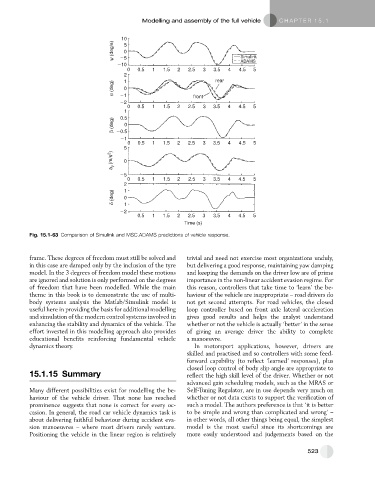Page 515 - Automotive Engineering Powertrain Chassis System and Vehicle Body
P. 515
Modelling and assembly of the full vehicle C HAPTER 15.1
10
ψ (deg/s) 5 0 Simulink
5
10 ADAMS
0 0.5 1 1.5 2 2.5 3 3.5 4 4.5 5
2 1 rear
α (deg) 1 0
2 front
0 0.5 1 1.5 2 2.5 3 3.5 4 4.5 5
1
0.5
β (deg) 0.5
0
1
0 0.5 1 1 1.5 2 2.5 3 3.5 4 4.5 5
5
a y (m/s 2 ) 0
5
0 0.5 1 1.5 2 2.5 3 3.5 4 4.5 5
2
δ (deg) 1 0
1
2
0.5 1 1.5 2 2.5 3 3.5 4 4.5 5
Time (s)
Fig. 15.1-63 Comparison of Simulink and MSC.ADAMS predictions of vehicle response.
frame. These degrees of freedom must still be solved and trivial and need not exercise most organizations unduly,
in this case are damped only by the inclusion of the tyre but delivering a good response, maintaining yaw damping
model. In the 3 degrees of freedom model these motions and keeping the demands on the driver low are of prime
are ignored and solution is only performed on the degrees importance in the non-linear accident evasion regime. For
of freedom that have been modelled. While the main this reason, controllers that take time to ‘learn’ the be-
theme in this book is to demonstrate the use of multi- haviour of the vehicle are inappropriate – road drivers do
body systems analysis the Matlab/Simulink model is not get second attempts. For road vehicles, the closed
useful here in providing the basis for additional modelling loop controller based on front axle lateral acceleration
and simulation of the modern control systems involved in gives good results and helps the analyst understand
enhancing the stability and dynamics of the vehicle. The whether or not the vehicle is actually ‘better’ in the sense
effort invested in this modelling approach also provides of giving an average driver the ability to complete
educational benefits reinforcing fundamental vehicle a manoeuvre.
dynamics theory. In motorsport applications, however, drivers are
skilled and practised and so controllers with some feed-
forward capability (to reflect ‘learned’ responses), plus
closed loop control of body slip angle are appropriate to
15.1.15 Summary reflect the high skill level of the driver. Whether or not
advanced gain scheduling models, such as the MRAS or
Many different possibilities exist for modelling the be- Self-Tuning Regulator, are in use depends very much on
haviour of the vehicle driver. That none has reached whether or not data exists to support the verification of
prominence suggests that none is correct for every oc- such a model. The authors preference is that ‘it is better
casion. In general, the road car vehicle dynamics task is to be simple and wrong than complicated and wrong’ –
about delivering faithful behaviour during accident eva- in other words, all other things being equal, the simplest
sion manoeuvres – where most drivers rarely venture. model is the most useful since its shortcomings are
Positioning the vehicle in the linear region is relatively more easily understood and judgements based on the
523

